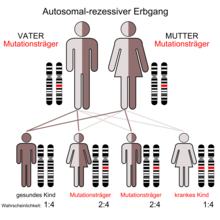Tangier disease
| Classification according to ICD-10 | |
|---|---|
| E78.6 |
Lipoprotein Deficiency Tangier Disease |
| E75.6 | systematized lipid deposition disease |
| ICD-10 online (WHO version 2019) | |
The Tangier disease is a rare inherited disorder of fat metabolism . In this disease, the release of cholesterol from the cell is disturbed, which on the one hand leads to a reduced formation of high density lipoproteins and on the other hand to increased cholesterol storage, especially in cells of the reticulohistiocytic system . The main symptom are yellow-orange spots on enlarged tonsils . In addition, diseases of the nerves , enlargement of the abdominal organs and increased arteriosclerosis can occur. Overall, the prognosis is favorable, and causal therapy is currently not possible.
The term “Tangier disease” is used synonymously in the literature with “an-α-lipoproteinemia (anal phalipoproteinemia)”, “familial HDL deficiency” and “familial hypoalphalipoproteinemia”.
Historical aspects and dissemination
The disease was named by Donald S. Fredrickson in 1961 after the island Tangier , which is isolated off the coast of Virginia , because the first two patients described came from there.
It is a rare disease . By 1978, 25 cases had been reported worldwide, by 1987 35 cases (including 21 with accompanying neurological symptoms) and by 2005 over 100 patients.
Cause and development of the disease
Tangier disease is inherited as an autosomal - recessive trait. The genetic defect underlying is localized on the long arm of chromosome 9 (9q31) and relates to the ABCA 1 - gene . The latter codes for a transport protein that is responsible for removing cholesterol from the cell.
The genetic defect disrupts the discharge of cholesterol from the cell, which together with apolipoprotein AI cannot contribute to the formation of high-density lipoprotein in the blood serum . This leads to an HDL deficiency with serum concentrations that are 100-200 times lower than that of normal persons, while cholesterol esters accumulate in the cell.
diagnosis
The main symptom is hypertrophic, yellow to orange colored almonds already in childhood . Fredrickson documented this change photographically in his first description. If the tonsils have been removed, reliable findings are small (1–2 mm diameter) spots in the mucous membrane of the anus . In addition to the typically changed tonsils, the levels of total cholesterol, triglycerides, HDL cholesterol and apolipoprotein AI in the blood are groundbreaking for the diagnosis . The α and pre-β bands in the lipoprotein electrophoresis are absent. The cholesterol level in the blood is below 100 mg / dl (mostly below 25 mg / dl) , the HDL cholesterol is missing, or the little that is still present in some cases is malstructured (like LDL and VLDL ) . The triglycerides , which can even be increased, are not affected . The apolipoprotein A-II is usually also reduced.
The clinical suspicion of Tangier disease can be confirmed by a human genetic examination. A nerve biopsy is usually not required to make a diagnosis.
Clinical picture
In addition to the already described enlargement and changes in the tonsils, muscle weakness and nerve symptoms , especially sensory disorders in the legs, as well as enlargement of the liver and spleen can occur. A massive enlargement of the pancreas has also been described in one individual case .
The absence of HDL cholesterol favors the development of arteriosclerosis . However, the course varies from person to person , so that coronary artery disease does not occur in some patients until they are older. Corneal opacity and changes in the blood count (e.g. haemolytic anemia , lack of blood platelets ) have also been described.
The neurological symptoms resulting from diseases of the peripheral nervous system can manifest themselves in three different forms. On the one hand as a distal sensorimotor neuropathy with sensory and movement disorders of the legs and arms, furthermore as a neuropathy affecting individual nerves (recurrent mononeuropathy) as well as a syndrome reminiscent of syringomyelia (pseudosyringomyelitic) with weakness of the facial muscles and the small muscles that begins in adulthood of the hand, missing or weak muscle reflexes , pain and temperature sensation and later also general sensory disorders in the trunk and extremities close to the trunk .
The nerve conduction velocity is normal in the first two forms mentioned. The extent to which these forms of disease differ not only in terms of tissue but also genetically has not yet been conclusively clarified, but is the subject of research.
pathology
In Tangier's disease, cholesterol esters are deposited in the macrophages of various tissues (e.g., peripheral and central nervous systems , spleen , lymph nodes , bone marrow , reticuloendothelial system , thymus , rectal lining, and skin ). These deposits are the cause of the clinically noticeable typical yellow-orange color of the tonsils . The fat-laden macrophages can be detected as foam cells in the infected tissues .
In the nerve biopsy of patients with the rare syringomyelia-like course, a sometimes pronounced reduction in myelinated and unmyelinated axons is found with evidence of vacuolization of Schwann cells and endoneural macrophages. In the (mono) neuropathic forms, only unspecific signs of de- and remyelination may be detectable.
Treatment and prognosis
A causal treatment of the disease has not yet been possible, but genetic engineering approaches are conceivable. A low-fat diet is generally recommended.
The prognosis is considered to be relatively favorable. In adulthood, however, there is an increased risk of developing vascular diseases, although a valid risk assessment is not possible due to the low number of known cases.
Individual evidence
- ^ Roche Lexicon Medicine , Urban & Fischer, 2003, ISBN 3-437-15150-9 , books.google.de
- ↑ E. Mayatepek: Pediatrics with student consultancy access . Urban & FischerVerlag, 2007, p. 239, ISBN 3-437-43560-4 , books.google.de
- ↑ a b c d H.-W. Baenkler: Internal Medicine . Thieme Verlag, 2001, p. 972, ISBN 3-13-128751-9 , books.google.de
- ↑ a b c d e f g h J.-M. Schröder et al .: Special Pathological Anatomy . Springer, 1999, ISBN 3-540-65612-X , p. 367 ff., Books.google.de
- ↑ a b c d e f g h G. Guder et al .: The laboratory book for clinic and practice . Urban & FischerVerlag, 2005, ISBN 3-437-23340-8 , pp. 252 ff., Books.google.de
- ↑ Fredrickson et al .: Tangier disease. In: Ann Int Med . , 1961, 55, p. 1016.
- ↑ Remaley et al .: Human ATP-binding cassette transporter 1 (ABC1): genomic organization and identification of the genetic defect in the original Tangier disease kindred. In: Proc Natl Acad Sci USA , 1999, 96 (22), pp. 12685-12690, PMID 10535983 , full text
- ↑ Brooks-Wilson et al .: Mutations in ABC1 in Tangier disease and familial high-density lipoprotein deficiency. In: Nat Genet. , 1999, 22 (4), pp. 336-345, PMID 10431236
- ↑ Young, Fielding: The ABCs of cholesterol efflux . In: Nat Genet . , 1999, 22 (4), pp. 316-318, PMID 10431227 .
- ↑ a b Photograph of tonsils of a patient with Tangier Disease ; profiles.nlm.nih.gov ; last accessed on December 18, 2008
- ↑ a b c d e f g D. Ganten: Handbuch der Molekularen Medizin , Springer, p. 334ff, ISBN 3-540-65529-8 , books.google.de
- ↑ a b c P. Berlit: Clinical Neurology . Springer, 1999, pp. 197ff., ISBN 3-540-65281-7 , books.google.de
- ↑ C. Sperti et al .: Abdominal localization of Tangier disease mimicking a pancreatic neoplasm . In: Eur J Gastroenterol Hepatol. , 10/2008, pp. 1028-1031, PMID 18787473
- ↑ a b C Serfaty-Lacrosniere et al .: Homozygous Tangier disease and cardiovascular disease . In: Atherosclerosis , 1994 May, 107 (1), pp. 85-98, PMID 7945562
- ↑ GD Kolovou, KK Anagnostopoulou, AN Pavlidis, KD Salpea, IS Hoursalas, A. Manolis, DV Cokkinos: Postprandial lipaemia in menopausal women with metabolic syndrome. In: Maturitas. Volume 55, Number 1, August 2006, pp. 19-26, ISSN 0378-5122 . doi: 10.1016 / j.maturitas.2006.01.002 . PMID 16443339 .
- ↑ Züchner et al .: A novel nonsense mutation in the ABC1 gene causes a severe syringomyelia-like phenotype of Tangier disease . In: Brain , 2003, 126 (Pt 4), pp. 920-927, PMID 12615648
- ^ W. Siegenthaler et al .: Clinical Pathophysiology . Thieme Verlag, 2006, ISBN 3-13-449609-7 , p. 158, books.google.de
- ^ Gibbels et al .: Severe polyneuropathy in Tangier disease mimicking syringomyelia or leprosy. Clinical, biochemical, electrophysiological, and morphological evaluation, including electron microscopy of nerve, muscle, and skin biopsies . In: J Neurol. , 1985, 232 (5), pp. 283-294, PMID 2997405
- ↑ Pollock et al .: Peripheral neuropathy in Tangier disease . In: Brain , 1983, 106 (Pt 4), pp. 911-928, PMID 6317140
- ↑ Peter Reuter: Springer Lexicon Medicine. Springer, Berlin a. a. 2004, ISBN 3-540-20412-1 .
- ↑ H. Begemann et al .: Handbook of internal medicine . Springer, 1968, ISBN 0-387-06355-2 , p. 268, books.google.de
- ↑ HR Schumacher et al .: Handbook of Hematologic Pathology . Informa Health Care, 2000, ISBN 0-8247-0170-4 , pp. 161-162, books.google.de

